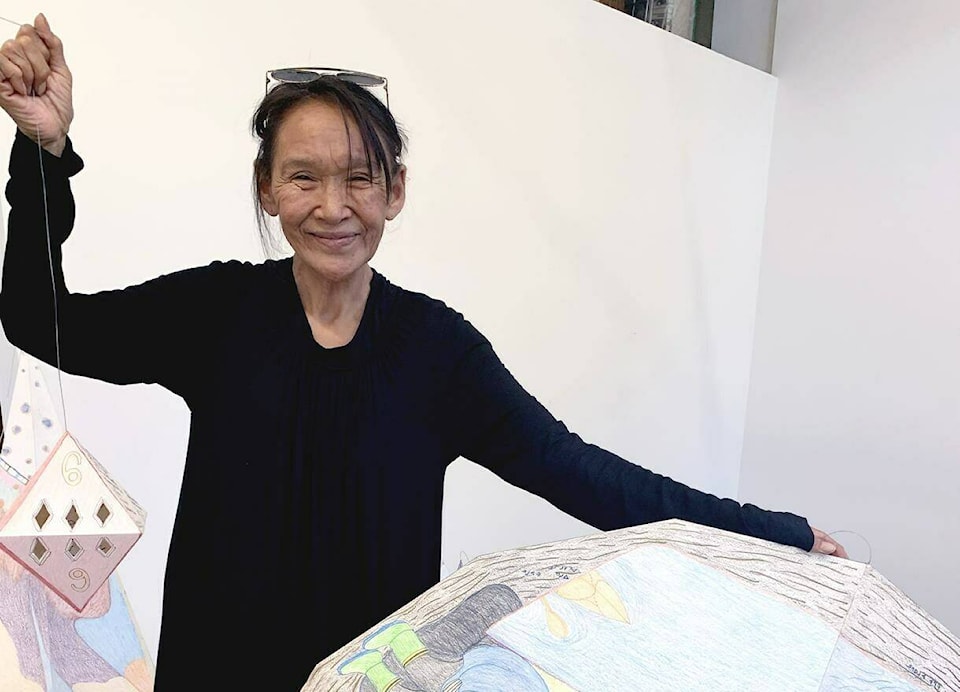Dozens, maybe hundreds, of Inuit artists have sketched polar bears. Only one is likely to have sketched polar bears sketching people.
She may also be the only Inuk to have drawn hunters taking aim at a walrus the size of an apartment block. Or octopuses with human legs and multiracial faces. Or a parka-clad woman juggling two worlds while giving birth to a third. Or works inspired by the Titanic. Or Godzilla.
Welcome to the world of Shuvinai Ashoona, the global art star from Kinngait, whose unique blend of fantasy, realism and nostalgia have made her one of the latest recipients of the Governor General’s Awards in the arts, Canada’s highest visual and media arts award.
“For me, drawings can come from what I see out there or what I don’t see around me,” Ashoona told The Canadian Press in an email. “Every time I draw something, it helps me to understand what I see and also what’s going on in my imagination.”
The artist, 62, prefers to conduct interviews through written questions translated into her native Inuktitut.
“Different people see so many different things when they look at drawings,” she said. “They’ll see things in a way that I hadn’t even thought of myself.”
Five other artists were also awarded: Barbara Astman of Toronto, whose photo-based work is in the Canadian Embassy in Berlin and on the cover of an album by the band Loverboy Montreal-based Dominique Blain, known for politically charged large-scale sculpture and installations Don Ritter, a Montreal artist whose sound and visual installations have been shown in 23 countries photographer Greg Staats, who looks at nature through Indigenous and settler lenses and Saskatchewan Metis documentarian Marjorie Beaucage, who has made 40 films.
Ashoona, whose work is shown across the country and around the world, comes from a long line of artists working out of the West Baffin Cooperative in Kinngait.
Her father, Kiugak Ashoona, and mother, Sorosilutu Ashoona, were both well known. Her grandmother, Pitseolak Ashoona, was one of the foremost Inuit artists of her time. Her cousin Annie Pootoogook won worldwide praise before her tragic and early death.
Shuvinai Ashoona spent plenty of time around West Baffin’s studios when she was young. But she was not an art kid.
“We’d play in the yard with older students during recess, and after school we’d visit our classmates at home,” she wrote. “I’d spend summer camping with Mom and Dad, and sometimes we’d have cousins camping with us.
“When I was younger, I wasn’t really interested in making art. I spent most of my time studying at school and at home. We did have art class at school. But at the time, I wasn’t very interested.”
She credits her sister Goota — an artist and one of 11 Ashoona siblings — with getting her started drawing in about 1996.
Patricia Feheley of Toronto’s Feheley Fine Arts, which has shown Ashoona’s work since 2006, has known the family since that time.
“Up there, you need a way to live,” Feheley said. “(Goota) felt Shuvinai was talented.”
Feheley recalls how the tiny pencil drawings Ashoona started with just kept getting bigger, more colourful — and weirder. Eventually, detailed documentary drawings gave way to entire sheets covered with brightly coloured eggs or a family confronting a rock crawling with what look to be cats with tentacles.
“She was literally letting her mind run amok.”
Yet traditional Inuit imagery such as seals and skin tents keep popping up. And that’s the key, said Robert Kardosh of the Marion Scott Gallery in Vancouver, which has also mounted many Ashoona shows.
“Sometimes in the same image she will juxtapose those two things — fairly naturalistically rendered people in their parkas in this fantastical world of creatures. Her vision can be very much not of this world.”
Inspiration can come from the everyday world around her, Ashoona said. But it rarely ends there.
“I see a lot of things on television and in books and magazines. And sometimes I’m interested in using those things in my artwork, like the way that I use things from my community, what’s around me and what I’m imagining.
“I don’t know where my work is going until I start to draw, and sometimes it even becomes something totally different than what I was thinking.”
Feheley has watched her work. Ashoona once started a piece by carefully drawing a hair braid in the middle of the sheet. Slowly, gradually, everything emerged around it.
“There’s no preliminary sketches,” Feheley said. “She just goes into it. That mind is just always everywhere.”
So is the art. Ashoona’s work has been shown to astonishment and praise in London, Venice, Sydney, Miami, New Mexico and Massachusetts. It hangs in Canadian public galleries and private collections from coast to coast. She regularly collaborates with artists in the south.
“I call her a super-connector,” said Kardosh.
“She bridges realms of experience in her work. She manages to say something about her specific locale, but she embraces the global vision, too.”
Ashoona’s work captivates a wide audience that goes far beyond a simple fascination with the Arctic, Feheley said.
“There’s no one else like her. Regardless of whether you’re from Australia or Germany, these images she creates just resonate with people.”
Governor General’s Awards winners receive a medal and $25,000. The citation for Ashoona’s award says she’s never content to follow rules and expectations.
“Ashoona’s unconventional artistic vision has successfully challenged and revolutionized how the public perceives Inuit art and contemporary Indigenous art more generally, helping to create a new space for expression and artistic freedom,” it says.
For Ashoona, it’s simpler.
“I don’t even think about getting awards,” she said.
“I’m very happy that people come to see my drawings. I want everyone to see my artwork.”
—By Bob Weber, The Canadian Press
